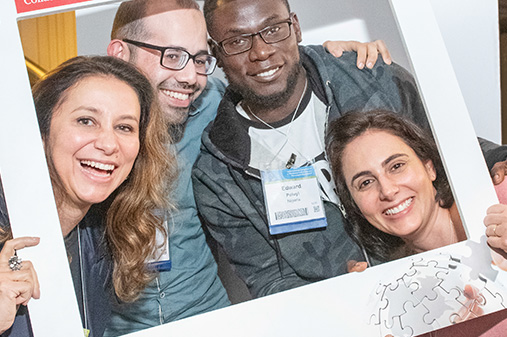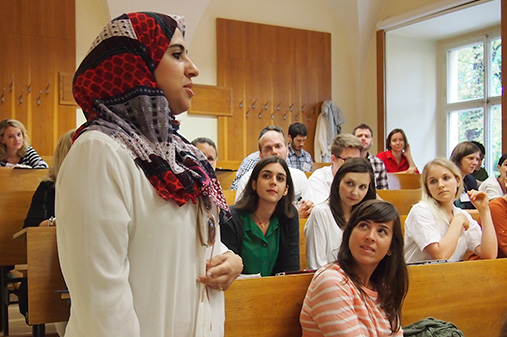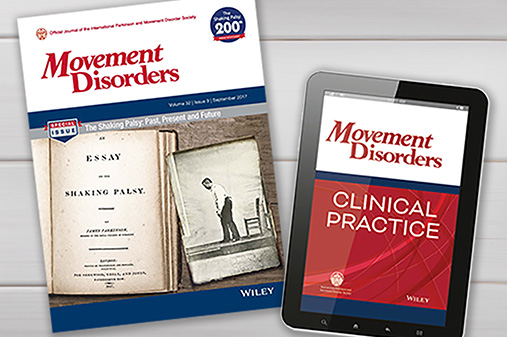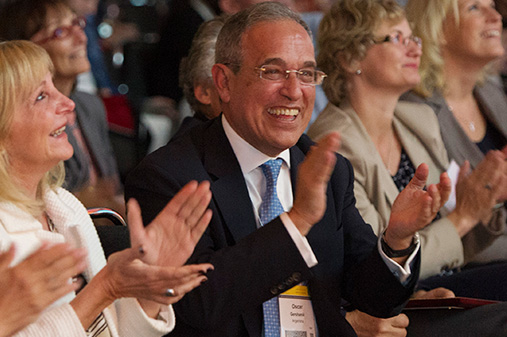Neurotrophic factors to restore dopaminergic terminals in Parkinson's disease: A viral vector-delivered genetic therapy
Journal CME is available until June 25, 2026
Read the article.
Dr. Michele Matarazzo: Hello and welcome to the MDS Podcast, the official podcast of the International Parkinson and Movement Disorder Society. I'm Michele Matarazzo, and today we're talking about the very exciting and challenging area of Parkinson's disease research, which is gene therapy. Specifically we'll discuss a recent phase 1B trial. Testing bilateral intraputaminal delivery of AAV2-GDNF, which is glial cell line derived neurotrophic factor in people with mild or moderate Parkinson's disease. As many of our listeners might know, neurotrophic factors like GDNF, but also others have long been promising therapeutic avenue in Parkinson's disease.
View complete transcript
But despite strong biological rationale and clear effects on dopaminergic neurons and good results in preclinical models, clinical translation has been very difficult so far. So this trial is part of a broader effort to overcome those problems. And joining me today is Dr. [00:01:00] Amber Van Laar, first and corresponding author of a paper recently published in Movement Disorders.
Amber is also an employee of AskBio, the sponsor of the clinical trial that we will be discussing today. So we disclose this to ensure full transparency for our listeners. Amber, welcome to the podcast and thank you for being here.
Dr. Amber Van Laar: Hello. Thank you so much for this opportunity.
Dr. Michele Matarazzo: Okay, so let's dive right in. Your team reports safety and some intriguing preliminary efficacy signals in this phase 1B trial. But before we get into the results and maybe discuss the results a bit, I'd like to step back for a moment and talk about GDNF. So has been studied for years as a potential therapy for Parkinson's diseases, and much of that interest comes from very compelling preclinical data. Could you briefly walk us through what the preclinical evidence for GDNF showed and why it generated so much enthusiasm in the field and we are talking about decades of research.
Dr. Amber Van Laar: Yes, [00:02:00] exactly. So I think one of the most exciting results is from I think the nineties showing that GDNF is requisite for dopamine neurons to develop and you need a little bit of GDNF. For them to continue to maintain their overall health. So that was a kind of a breakthrough moment. I think there was a lot of excitement for GDNF for Parkinson's, specifically for this, benefit for dopaminergic neurons.
And I remember when this paper came out and immediately the next question was, oh my gosh, how are we gonna get it in the brain? How are we going to get it there? And here we are, I would argue about three decades later, and I think we finally figured out how exactly to do this. But with GDNF, there's a lot of promise not only with the ability to make neuro-dopaminergic cells healthier and help them survive better, but there was some evidence of sprouting also of the dopaminergic network, which is another important feature of GDNF.
Dr. Michele Matarazzo: Great. After all this evidence, there have been a number of clinical trial testing, GDNF and other neurotrophic factors in Parkinson's, including some using viral delivery rather than protein [00:03:00] infusion, like your study. And we know none of them has really shown clear clinical benefits so far. Now your approach is different in a number of ways.
Gene delivery versus protein infusion. Convection enhanced delivery, which is a fancy name that you will tell us what is about, MRI guidance, even the approach you use a posterior approach. Can you talk us through what you see as the key differences in your delivery system and why you think they might make a difference?
Dr. Amber Van Laar: It was a big challenge. Neurosurgeries has primarily been taking things out of the brain and now we're trying to put drugs into the brain and that, that actually took a long time to figure out how to do that and do it safely. And when you're trying to target a particular nucleus, like the putamen, like we are, even more so how do you really contain and maintain the accuracy.
So this convection enhanced delivery is one way for us to help push the gene therapy into the right parts of the brain in a really evenly distributed way. So that was a [00:04:00] big step in trying to get proper drug development into the brain itself. The technique, allows us for direct delivery right to the putamen, which is a important part of the dopaminergic system for us.
It is downstream from the substantial nigra, but allows us to address, the downstream end. This is where we expect to see a lot of the sprouting to occur. This is where we think we're gonna see a lot of the benefit from it. But by using this technique as well from a delivery technique we're taking advantage of.
The networks that already exist. So we're also getting advantage of the vectors actually able to transport from the putamen back to substantial nigra in the reticulata. Now, GDNF is also secreted, so we actually get benefit all the way back at the level of the nigra as well as the putamen with this approach.
So allows us to take advantage, of the normal anatomy, let's say. And we don't get that quite advantage with the protein infusions. There are intermittent you don't get this constant, level of GDNF that is elevated like we see with a gene therapy approach.
Like what we're doing here.
Dr. Michele Matarazzo: And another question [00:05:00] is the quantity of the virus and the therefore the gene that you are injecting and the coverage of the putamen. So can you discuss about this a little bit?
Dr. Amber Van Laar: So with gene therapy it's not just the amount of gene therapy we're putting in, it's actually how many cells pick up the gene and then express it. That's really our target. That's the medication here. So the idea then is that in order to make more GDNF, you need more cells picking it up, and therefore you need better coverage of your putamen.
So that was a major effort of what we're trying to do with this. This other approach as you had mentioned. So by taking a posterior approach, going through a prior occipital trajectory, it allows us to get the long edge of the putamen, the long axis so we can really fill up the putamen again with this idea that the more cells that we are able to transduce with our gene, the more GDNF that we'll get.
And I think that was a big difference between what we've seen and a few other of the gene therapy and growth factor studies that have been done in the past.
Dr. Michele Matarazzo: Great. Now let me ask you something else. One of the trials as have [00:06:00] that have been done so far was published few years ago, I think it was a paper published in Brain, by Whone and colleagues with GDNF infusions in about 40 patients or so. It was safe it had an improvement from the imaging point of view, so it did something to the dopamine in the brain.
But the patients were quite similar between the placebo and the treated arm of the trial. How do you interpret those mixed results? When you were planning your study how did you put this in the story and did you change the way you were thinking about your clinical trial?
Looking at also these results.
Dr. Amber Van Laar: Definitely. And I just wanna add in, we actually had a phase 1 study that was conducted before this paper. And in that study starting in 2013, we actually saw improvements in fluorodopa. Not too dissimilar to what they had seen with the protein infusion studies, with the Bristol group.
So I think some of the key differences are, we said this is part of why we changed the trajectory. So that would help us improve coverage, help [00:07:00] us, get better GDNF coverage as well. This is also where, it's important to the differences you know, higher levels expression of GDNF that we are able to achieve with the viral approach.
Versus a recombinant protein approach. The other thing is like with the recombinant GDNF, it's made a little bit different so the body sees it a little bit differently. So you may not be getting the full response versus more of an endogenous GDNF that's made with a gene therapy approach.
That may help as well. But this also changed the population we looked at. It also changed the timing that we were looking at. 'Cause they were looking at, I think nine months and little and then on. And so I think really from a placebo effect, when we're talking Parkinson's with the population we're talking about.
I think time is really where you need to start to, look for a separation. Now that being said, we haven't looked at GDNF gene therapy yet until just now in a blinded approach. And that's really gonna be key to see this. But there's been a lot of smoke. I have to think there's some fire there.
Dr. Michele Matarazzo: Yeah. And you're right, there are so many things you can play with when designing these kind of [00:08:00] trials, both from a technical point of view, from the clinical trial design point of view, that really believing in that the molecule will work. Then there are a lot of well, and with the compelling preclinical evidence we have that, then there are so many factors that you have to keep into consideration when actually going into humans.
That makes it quite difficult, right?
Dr. Amber Van Laar: The time. Time is critical. This is Parkinson's. It doesn't happen quickly. We need to give it time to, to see if these therapeutics are working too.
Dr. Michele Matarazzo: Indeed. Now, before we get into details, some details of the efficacy, which is part of the results here, I want to touch on the main goal of this phase 1B study, which was safety and tolerability. What did you see in terms of adverse events and were there any findings on imaging or clinically that you found surprising or particularly relevant, important from the safety point of view?
Dr. Amber Van Laar: Yeah. It was interesting 'cause there's very, it just very clear there were a lot of adverse events that occurred around the time of [00:09:00] surgery that were not that big surprise. And there was like everything else that happened, after surgery. So we ended up splitting up our, like perioperative events versus postoperative events.
Because they're very, very different. So we expected, you are flat, you're prone in the MRI for this procedure. This is all done under serial MRI. And so yeah, we get some pains in the shoulders, the hips, a lot of musculoskeletal type of complaints just from positioning.
A lot of these things are limited. They go away on their own, maybe some Tylenol. There's headaches again. These are things that are to be expected after brain surgery, these sorts of things. And then there's always a little bit of worsening of tremor, dyskinesia. Also around the time of surgery, usually this is anxiety.
But beyond that, we were doing most of the study during the time of COVID, so we saw a lot of COVID pop up which is not a big surprise. I guess the one surprise that we saw is compared to the phase 1 study that looked at a more advanced population, we really didn't see some of the, maybe some of the cognitive changes, the hallucinations that may have occurred. I think it's 'cause we're dealing with a younger, [00:10:00] maybe slightly healthier less affected PD population. No big surprises though from a safety standpoint. I think overall this was really well tolerated and would be considered safe.
We did see some hypointensities on MRI that we were reported in the paper. These were small, incidental, we only found them because we were checking, to see if there was any changes. They looked stable over time. And this happened in very few people. So it's something that I think, we're normalizing what does drug delivery in the brain look like?
We're not leaving any hardware behind like you would see with DBS, but there's gotta be stigmata that we were there in the brain and what does that look like? And I think that's a lot of what we're also trying to understand right now with this type of technique.
Dr. Michele Matarazzo: And did this happen just after the treatment or it was something that you saw, months after?
Dr. Amber Van Laar: We had no reason to go look for anything 'cause the patient was actually doing quite well. And so we were getting regular MRIs as part of our monitoring and that's where we found it. It was at as at that time.
Dr. Michele Matarazzo: Okay. And now looking at the preliminary efficacy signals in the paper [00:11:00] you described that the mild group basically stayed stable while the moderate group actually showed some numerical improvements. Like lower UPDRS, less OFF time, even reduced levodopa requirements. Can you walk us through those findings in a bit more details and how do you make sense especially of the difference between the two groups?
Dr. Amber Van Laar: Yeah, it was also an important decision for us to look at mild versus moderate, compared to, other GDNF studies that had suggested that it would be better to go into an earlier PD population. And so we tried it in this study. So on average, they were about close to two years from diagnosis.
Our moderate group was about seven and a half, eight years from diagnosis. And expected, like their UPDRS scores looked, about what you would expect from diagnosis. So we did see, you know, I would argue stability in our moderate group. There were some of the participants though that did demonstrate some, up to about 10 points of improvement on UPDRS part three.
By and large, they've remained quite stable. We did have one participant in the mild group that was found to have a TH [00:12:00] mutation that I think ended up being somewhat symptomatic, particularly for her OFF scores. So especially if you take her out of the analysis, everything is completely flat. Now that looks really boring.
But I would argue especially for, an early PD patient, they're a year or two into their disease, if they could stay there, if we really can see that there's the stability that lasts, for years, I think that would be quite remarkable. We haven't seen anything do that quite yet, and so I, I think there's a lot of value to be seen in the long term effects from this mild group.
They were not that bad to begin with, so that room for improvement, there really wasn't much. And so I think that is part of why we just don't see much change over time. But again, I think that's actually the benefit of GDNF versus our more moderate group. They've already had more loss.
They've already had, much worse, scores on their UPDRS. There's much more room for us to demonstrate improvement. And I think that's why they look so different. And again, I think with the mechanism of action of GDNF, if we really are asking, the system to regrow [00:13:00] resprout and basically reconnect in a way, it takes time.
I think that explains the time component with what we're seeing. But it's interesting that our OFF scores improved to the point where it looks like they were on their ON scores before. And I think that really kinda suggests the sort of turning back the clocks. It's more getting back to more mild look in the dopaminergic system is what that looks like.
So again, the value here is gonna be in time what this looks like. Can we see that durability in, and I think on top of all of this, reducing that Levodopa equivalent dose is also really remarkable. We're seeing these improvements in both OFF state, ON state. In part to, plus reducing levodopa in some cases.
And to me, this just altogether in totality suggests that GDNF is doing what we thought it was going to do.
Dr. Michele Matarazzo: Fantastic. Now, I think it's important here to mention that first of all, you say time is key. So I think you plan to follow these patients right?
Dr. Amber Van Laar: So there, there are regulatory requirements for at least five years for gene therapy. I think again, [00:14:00] there is major value for us to continue to do that. We'll follow even longer than that and I ideally, we postmortem evaluation at some point.
Dr. Michele Matarazzo: Okay. And actually, I don't know if we said that already during this interview, but another important difference between protein infusion or neurotrophic factor infusion and the gene therapy is that the gene therapy is a one shot therapy.
Dr. Amber Van Laar: One and done. Yep.
Dr. Michele Matarazzo: And is that really true? Is that really the case?
Or do we have evidence that, in the long run we don't need another shot of
Dr. Amber Van Laar: Yeah. I'm glad you asked. Again, because of the direct delivery right to the brain that's one thing for us. And right now we have evidence so there's some primate evidence suggesting I think up to eight years of continued expression.
And the phase 1 study done, many years ago that I had mentioned, there was one participant who passed away from a back surgery. There was evidence, I think it's almost four years from the time he was infused, there was still GDNF that was being produced where it had been delivered. So we have some evidence there.
There's also [00:15:00] AAV2-neurturin, so very similar, a homolog to GDNF where they've looked out 10 years or longer. And these can still see some expression there. It's the benefit of going to the brain, going straight to the neurons and asking them to, gently make, these neurotrophic factors.
Long term it does seem like this is durable. Now does that translate to a clinical effect? We still need to do that experiment.
Dr. Michele Matarazzo: Good. And as we are talking about viruses here something else would like to have your thoughts about is there are some groups in the gene therapy field that are looking into AAV9. Because of its ability to cross the blood barrier also for immune related things. Why did you decide to stick with AAV2 for this study and do you think there's a role for AAV9 or maybe other serotypes of adeno-associated viruses?
Dr. Amber Van Laar: AAV2 is old. It's one of the first serotypes that was identified. However, we stuck with it because it's sticky. It likes to stay where it's put, and that is exactly what we want it to do and perform for [00:16:00] us, we want it to stay in the putamen or within the nigrastriatal system, as I've alluded to before.
So that's a big benefit. AAV2 also is not as immunogenic as a lot of the other serotypes. It actually seems to put the immune system at bay. And again, I think, t he technology's advancing incredibly fast. We have way more capsids than just AAV2 and 9. There's, a lot of iterations off of nine because it's really good at spreading and can cross the brain barrier.
It still is not great at getting to the deep nuclei. So though it can spread, it can cross. It's not good at getting deep parts of the brain. And if that is still a desired target, direct delivery to the brain is still probably gonna be the right place. And not for every gene therapy is gonna be appropriate to be, delivered, across the entire CNS.
You don't want that necessarily for every type of disease indication. And sometimes we need to get more target and smarter about it. And this is part of why we stuck with the AAV2.
Dr. Michele Matarazzo: Oh, that makes sense. So we're approaching the end of this interview. Let me wrap up with a couple of follow [00:17:00] up questions on the future of the field. So this phase 1B study, achieved this main goal of safety and the preliminary efficacy signals are definitely interesting, at least of course, it's still very early, early.
Of course, there was no placebo arm, it was not a blinded study. Now you are working on a new trial, which is already running which is called the Regenerate PD trial. Can you tell us a little bit more about this?
Dr. Amber Van Laar: Yeah. So it's, very clear. We were excited by what we had seen in the phase 1Bs as we just discussed. And again, looking at that moderate group and seeing, again, signal of change was noticeable. And decided to then move that now into a bigger blinded randomized control study.
So this is really first of its kind that's been able to do this. It's very challenging to do a blinded neurosurgical study and then to do this for years on top of all of that. This is, it's hard for us. It's hard for on the participants. This is a big challenge. And right now we are open in the [00:18:00] US and we have, I think every country in the EU is open right now.
So UK Germany, Poland, so trying to get this study up and running, this is really our first chance to look and ask the questions in a blinded manner of AAV2 GDNF. So this is gonna be really critical, taking a lot of the elements from what we learned in the phase 1B, taking really that moderate group.
And then just again asking what happens in compared to placebo. So this is it'd be very interesting to see what these results look like in a few years.
Dr. Michele Matarazzo: Thank you very much. It's been a pleasure to have you here with me, Amber. Thank you for joining me and for sharing all this very interesting results and insight on this fascinating world of gene therapy in Parkinson's disease.
Dr. Amber Van Laar: Thank you so much. It was a real pleasure.
Dr. Michele Matarazzo: And thanks also to all our listeners for tuning to the MDS Podcast. If you'd like to read the full article, it's available now on the Movement Disorders Journal, and thank you all for listening. [00:19:00] [00:20:00]
Amber D. Van Laar, MD
AskBio
Columbus, OH, USA









